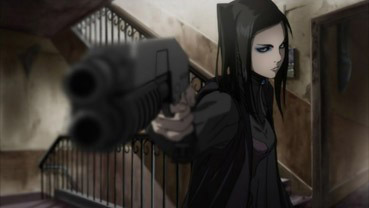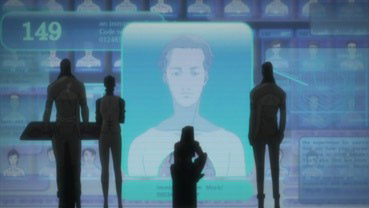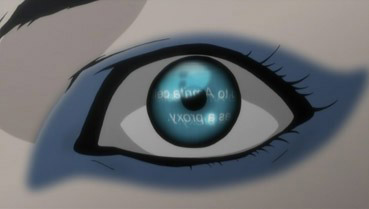|
To
describe Ergo Proxy as a dark, futuristic
drama is to be imprecise in a genre that has seen more than
its share of dark futuristic dramas, but will at least provide
a starting point for those with an interest in this particular
anime sub-genre. Many of the elements have the comfort of
familiarity, from the favourite theme of individuality verses
the state to a narrative that isn't prepared to wait for
stragglers and demands serious concentration to initially
make sense of. There's even a gun-toting female cop, a governmental
conspiracy and murderous mutations thrown into the mix.
And there are androids, androids that are becoming self-aware
and breaking free of human control. Blade
Runner, anyone? But Ergo Proxy
has its own distinctive and thoughtful take on these building
blocks. And Ergo Proxy has style.
At
an unspecified future date when the planet has suffered
severe environmental deterioration, the citizens of the
domed city of Romdo live a comfortable
but essentially sterile and emotionless existence. There is tight control over the population
level and androids known as AutoReivs make up much of the
workforce gap that such a policy has created, and just about every citizen
of Romdo appears to own one. They have a generic, featureless
appearance that can be tailored to provide a specific function –
a female companion for the lonely male or a young daughter
for an as-yet childless mother. Many serve as assistants
in a professional capacity, medical orderlies for doctors
or a driver and researcher for a police detective. These
personal AutoReivs are known as Entourage.

But
in the manner of such things, at least as they play out
in sf films and literature, problems have developed. A cogito
virus is infecting an increasing number of AutoReivs and
is causing them to achieve self-awareness and flee the city
by an as-yet undiscovered route. A bigger problem exists
in the shape of a powerful and dangerous creature known
as a Proxy, which has escaped from a government laboratory and is at large
somewhere in the city, its existence known only to a select
and secretive few in positions of power. The problem is
that it occasionally pops up and kills people, and keeping
it hushed up is becoming increasingly difficult.
Re-l
(pronounced Reh-El) Mayer, a hard-nosed
but beautiful female Intelligence Bureau detective, knows nothing of the Proxy, that is until it drops
through her bathroom ceiling. Instead of killing her, it
wipes her lip and sheds a tear before being attacked
by a second proxy, one that Re-l herself caught a brief glimpse
of earlier that day. Re-l escapes with her life but her
colleagues disbelieve her story, dismissing it as a panic-induced
hallucination and blaming the whole thing on Vincent Law,
a timid immigrant worker for the AR Processing Facility
who has a bit of a thing for Re-l (understandable, as it
happens) and who was found unconscious at her apartment block
the evening of the encounter. Initially confused and frustrated
by this response, Re-l suspects a widespread conspiracy
to cover up the attack and her account of it, something
that extends to the control of her own loyal AutoReiv, Iggy.
Temporarily relieved of her duties pending a favourable
psychiatric report, Re-l decides to investigate the incident
herself.
As
you can see, there's a lot of plot to cope with and I'm just giving you the first episode basics here.
I haven't even mentioned Romdo's all powerful City Administrator,
Regent Donov, who is Re-l's grandfather and the only reason
she's able to walk around unmolested following her encounter.
Then there's the new head of the Security Bureau, Raul Creed, who's been charged both with
the job of capturing the Proxy and keeping its existence and that of the cogito virus from spreading
to the general populace. It's also worth mentioning that Romdo is a heavily controlled
society in which Citizens have a higher status than the
lowly Immigrants, who aspire to citizenship but are forced
to live in communities away from the general populace.

And
then there's Pino, a 'Pet-Model' AutoReiv with the appearance
of a pre-teen girl, a substitute
daughter for Raul's arrogant wife and whose function is
due to change now that the Department of Welfare and Human Affairs
have permitted her owner to have a real child. Interesting in her
own right (particularly in the way her human characteristics
can be switched on and off by her owner), Pino soon becomes
one of the series' most intriguing characters, particularly
when a Proxy-caused mall massacre leaves her ownerless and she
hooks up instead with the terrified Vincent, who for reasons
unknown has become the main target of the second Proxy's
predatory fury.
I
could go on. Plotted with a density that would leave most
live action genre pieces at the starting gate (the combined
running time of the four episodes here is that of an average
feature), the narrative complexity is enhanced by a scholar's
attention to detail, from technology that feels logically
developed from present day hardware to the almost sleight-of-hand
delivery of key character and plot information. There are also a number of engagingly
suggestive throwaway moments, such as when the letters of
Vincent's alphabetic breakfast cereal surface to form a word that Re-l will soon find scrawled on her
bathroom mirror, or the almost subtextual references
to major philosophers and thinkers, from René Descartes
to Alfred Turing. Much of this becomes evident only on a
second viewing, something I'd recommend anyway to fully
clarify the initial plot complexities of the first episode.
The
animation is unexceptional, although there is a seamless
integration of computer and hand-drawn imagery and a nice
use of depth-of-field and focus-pulls. The design, however, is distinctive and atmospheric,
the dark industrial landscape often drained of primary colours,
and Re-l is given the rare distinction for a female anime character
of being geometrically correct whilst retaining that favourite
generic mix of beauty and lethality. The sound design adds
much to the dystopian aura, whilst Yoshiro Ike's music,
all ominous notes, repeated electronic rhythms and Gregorian
chants, contributes greatly to the show's dark design. It
even has Radiohead's Paranoid Android over the
end credits.
Opinion
in anime fandom is a little divided on later direction
the show takes, but I'll reserve judgement until I see the episodes in question,
and see them I'm keen to do. The influences are obvious
– Blade Runner, Ghost
in the Shell, Orwell's 1984, Asimov's I, Robot
and Huxley's Brave New World are just five of several –
but Ergo Proxy uses some familiar tools
to carve a distinct identity of its own, and although episode
4 may not have ended on a narrative cliffhanger, I still
let out an audible groan when it came unexpectedly to an
end. Roll on volume 2.
Volume
1 includes the first four episodes: Awakenings,
Confession, Mazcity, Futu-risk.
The
anamorphic 1.78:1 picture has to cope with some unusually
dark scenes for an anime series, a problem amplified by
the restricted colour palette. It does well here, retaining
black level solidity but keeping the detail clear. It's hard
to be sure of this is an NTSC to PAL conversion or has been
pulled directly from the HD master – the usually giveaway
double-image freeze frames are there, but only some of the
time, and the animation style itself can create such effects.

Soundtrack-wise you have a choice between Japanese Dolby
5.1 surround, English Dolby 5.1 surround and English DTS
5.1 surround and there's sonically little to choose between
them, so it all comes down to personal preference. Separation
and surround work are both very good, and the bass kicks
when it needs to. The English dub is pretty good, but the
characters have a little less gravity than on the Japanese
track.
The
subtitles are pretty much dubtitles, matching the English
track almost word-for-word, although sentences are compressed
for easy reading. As with volume 1 of Speed
Grapher, the Japanese curse "shit"
has been downgraded to "dammit."
Keywords
of Ergo Proxy (3:32)
One of two featurettes made to build up anticipation for
the first Japanese TV screening. Narrated in a hyper-enthusiastic
style that will be familiar to anyone who has spent time
in front of a TV in a Japanese hotel room, it uses some
of the key words from the series – Romdo, Cogito, Proxy
– as a springboard for a busy teaser. It has it's amusing
side, as when our narrator cheerily informs us that Iggy
"speaks in a manner as if he were gay!" It's an
indication of the cultural and technological differences
in our two cultures that the series was broadcast back in
February 2006 in full HD with 5.1 sound.
Behind
the Scenes (4:32)
Part 2 of the above with the same excitable narrator, but
including a tour of the Manglobe animation offices and a
brief interview with shade-wearing director Shokou Murase.
English
Staff Interview (32:24)
A slightly misleading menu title for what is actually a
US Staff Interview with English language voice director
Jonathan Klein and English version script editor Taliesin
Jaffe. A thoroughly likeable and knowledgeable pair, their
considerable enthusiasm for the series is informed and infectious
and I found myself agreeing with them on many things, including
their choice of favourite character. One to watch after
the main feature (there are plenty of spoilers otherwise),
this is an engaging extra that runs for a decent length.
Clean
Opening (ep 1 & 2) (3:09)
Textless opening sequences for the first two episodes.
Promotional
Trailers
Cinema and TV-spot style trailers for the series, consisting
of Full Version (3:34), Half Version (0:32)
and Quarter Version (0:17).
Commercials
Similar to above but for the DVD release. Again the three
included are Full Version (1:44), Half Version
(0:32) and Quarter Version (0:17).
Galleries
Rolling galleries of character drawings, including sketches,
featured large to fill the widescreen frame. These are genuinely
interesting and are subdivided as Characters (2:17),
AutoReivs (0:32), Props (1:36) and Romdo
(1:10).
Trailers
The usual trailers for other MVM releases, in this case
the American one for Speed
Grapher (1:26) and the Japanese for Gun
Sword (1:37). Both are weak sells.
Another
worthwhile adult anime series makes it to UK DVD. If you're
a fan of future imperfect science fiction then Ergo
Proxy should be right up your street and has enough
style and ideas of its own to ride out the borrowings. MVM's
DVD is a very good one, with a strong transfer, a well mixed
soundtrack and an above-average collection of extras. Recommended.
|